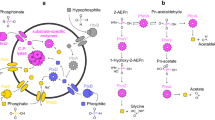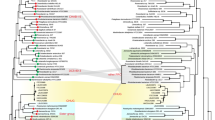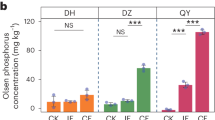Abstract
Nutrient limitation is an environmental stress that may reduce the effectiveness of bioremediation strategies, especially when the contaminants are organic compounds or when organic compounds are added to promote microbial activities such as metal reduction. Genes indicative of phosphate-limitation were identified by microarray analysis of chemostat cultures of Geobacter sulfureducens. This analysis revealed that genes in the pst-pho operon, which is associated with a high-affinity phosphate uptake system in other microorganisms, had significantly higher transcript abundance under phosphate-limiting conditions, with the genes pstB and phoU upregulated the most. Quantitative PCR analysis of pstB and phoU transcript levels in G. sulfurreducens grown in chemostats demonstrated that the expression of these genes increased when phosphate was removed from the culture medium. Transcripts of pstB and phoU within the subsurface Geobacter species predominating during an in situ uranium-bioremediation field experiment were more abundant than in chemostat cultures of G. sulfurreducens that were not limited for phosphate. Addition of phosphate to incubations of subsurface sediments did not stimulate dissimilatory metal reduction. The added phosphate was rapidly adsorbed onto the sediments. The results demonstrate that Geobacter species can effectively reduce U(VI) even when experiencing suboptimal phosphate concentrations and that increasing phosphate availability with phosphate additions is difficult to achieve because of the high reactivity of this compound. This transcript-based approach developed for diagnosing phosphate limitation should be applicable to assessing the potential need for additional phosphate in other bioremediation processes.
Similar content being viewed by others
Log in or create a free account to read this content
Gain free access to this article, as well as selected content from this journal and more on nature.com
or
References
Aguena M, Yagil M, Spira B . (2002). Transcriptional analysis of the pst operon of Escherichia coli. Mol Genet Genomics 268: 518–524.
Allenby NEE, O’Connor N, Pragai Z, Carter NM, Miethke M, Engelmann S et al. (2004). Post-transcriptional regulation of the Bacillus subtilis pst operon encoding a phosphate-specific ABC transporter. Microbiology 150: 2619–2628.
Altschul SF, Gish W, Miller W, Myers EW, Lipman DJ . (1990). Basic local alignment search tool. J Mol Biol 215: 403–410.
Anderson RT, Vrionis HA, Ortiz-Bernad I, Resch CT, Long PE, Dayvault R et al. (2003). Stimulating the in situ activity of Geobacter species to remove uranium from the groundwater of a uranium-contaminated aquifer. Appl Environ Microbiol 69: 5884–5891.
Bardin SD, Finan TM . (1998). Regulation of phosphate assimilation in Rhizobium (Sinorhizobium) meliloti. Genetics 148: 1689–1700.
Bazylinski DA, Dean AJ, Schuler D, Phillips EJP, Lovley DR . (2000). N2-dependent growth and nitrogenase activity in the metal-metabolizing bacteria, Geobacter and Magnetospirillum species. Environ Microbiol 2: 266–273.
Botero LM, Al-Niemi TS, McDermott TR . (2000). Characterization of two inducible phosphate transport systems in Rhizobium tropici. Appl Environ Microbiol 66: 15–22.
Christ JA, Ramsburg CA, Abriola LM, Pennell KD, Loffler FE . (2005). Coupling aggressive mass removal with microbial reductive dechlorination for remediation of DNAPL source zones: A review and assessment. Environ Health Perspect 113: 465–477.
Coppi MV, Leang C, Sandler SJ, Lovley DR . (2001). Development of a genetic system for geobacter sulfurreducens. Appl Environ Microbiol 67: 3180–3187.
Elifantz H, N’Guessan AL, Mouser PJ, Williams KH, Wilkins MJ, Ward JE et al. (2008). American Society for Microbiology 108th General Meeting, Boston, MA.
Esteve-Nunez A, Rothermich M, Sharma M, Lovley D . (2005). Growth of Geobacter sulfurreducens under nutrient-limiting conditions in continuous culture. Environ Microbiol 7: 641–648.
Finneran KT, Anderson RT, Nevin KP, Lovley DR . (2002). Potential for bioremediation of uranium-contaminated aquifers with microbial U(VI) reduction. Soil Sedim Contam 11: 339–357.
Fischer RJ, Oehmcke S, Meyer U, Mix M, Schwarz K, Fiedler T et al (2006). Transcription of the pst operon of Clostridium acetobutylicum is dependent on phosphate concentration and pH. J Bacteriol 188: 5469–5478.
Gachter R, Meyer JS . (1993). The role of microorganisms in mobilization and fixation of phosphorus in sediments. Hydrobiologia 253: 103–121.
Gebhard S, Tran SL, Cook GM . (2006). The Phn system of Mycobacterium smegmatis: a second high-affinity ABC-transporter for phosphate. Microbiology-Sgm 152: 3453–3465.
Harris RM, Webb DC, Howitt SM, Cox GB . (2001). Characterization of PitA and PitB from Escherichia coli. J Bacteriol 183: 5008–5014.
Hinchee RE, Kittel JA, Reisinger HJ . (1995). Battelle Press: Columbus, OH (United States): United States, 547 pp.
Holmes DE, Finneran KT, O’Neil RA, Lovley DR . (2002). Enrichment of members of the family Geobacteraceae associated with stimulation of dissimilatory metal reduction in uranium-contaminated aquifer sediments. Appl Environ Microbiol 68: 2300–2306.
Holmes DE, Nevin KP, Lovley DR . (2004a). Comparison of 16S rRNA, nifD, recA, gyrB, rpoB and fusA genes within the family Geobacteraceae fam. nov. Int J Syst Evol Microbiol 54: 1591–1599.
Holmes DE, Nevin KP, Lovley DR . (2004b). In situ expression of nifD in Geobacteraceae in subsurface sediments. Appl Environ Microbiol 70: 7251–7259.
Holmes DE, Nevin KP, O’Neil RA, Ward JE, Adams LA, Woodard TL et al. (2005). Potential for quantifying expression of the Geobacteraceae citrate synthase gene to assess the activity of Geobacteraceae in the subsurface and on current-harvesting electrodes. Appl Environ Microbiol 71: 6870–6877.
Istok JD, Senko JM, Krumholz LR, Watson D, Bogle MA, Peacock A et al. (2004). In situ bioreduction of technetium and uranium in a nitrate-contaminated aquifer. Environ Sci Technol 38: 468–475.
Johnson SE, Loeppert RH . (2006). Role of organic acids in phosphate mobilization from iron oxide. Soil Sci Soc Am J 70: 222–234.
Krol E, Becker A . (2004). Global transcriptional analysis of the phosphate starvation response in Sinorhizobium meliloti strains 1021 and 2011. Mol Genet Genomics 272: 1–17.
Lee PKH, Macbeth TW, Sorenson KS, Deeb RA, Alvarez-Cohen L . (2008). Quantifying genes and transcripts to assess the in situ physiology of “Dehalococcoides” spp. in a trichloroethene-contaminated groundwater site. Appl Environ Microbiol 74: 2728–2739.
Lin B, Braster M, van Breukelen BM, van Verseveld HW, Westerhoff HV, Roling WFM . (2005). Geobacteraceae community composition is related to hydrochemistry and biodegradation in an iron-reducing aquifer polluted by a neighboring landfill. Appl Environ Microbiol 71: 5983–5991.
Lovley DR . (1991). Dissimilatory Fe(III) and Mn(IV) reduction. Microbiol Rev 55: 259–287.
Lovley DR . (2002). Analysis of the genetic potential and gene expression of microbial communities involved in the in situ bioremediation of uranium and harvesting electrical energy from organic matter. OMICS 6: 331–339.
Lovley DR . (2003). Cleaning up with genomics: applying molecular biology to bioremediation. Nat Rev Microbiol 1: 35–44.
Lovley DR, Baedecker MJ, Lonergan DJ, Cozzarelli IM, Phillips EJP, Siegel DI . (1989). Oxidation of aromatic contaminants coupled to microbial iron reduction. Nature 339: 297–300.
Major DW, McMaster ML, Cox EE, Edwards EA, Dworatzek SM, Hendrickson ER et al. (2002). Field demonstration of successful bioaugmentation to achieve dechlorination of tetrachloroethene to ethene. Environ Sci Technol 36: 5106–5116.
Martani E, Seto M . (1991). Effects of mineral nutrients on the degradation of 2,4-dichlorophenol at low concentrations by microbial community and bacterial isolates. J Pesticide Sci 16: 1–7.
Mc Callister DL, Logan TJ . (1978). Phosphate adsorption-desorption characteristics of soils and bottom sediments in the Maumee river basin of Ohio. J Environ Qual 7: 87–92.
Methe BA, Nelson KE, Eisen JA, Paulsen IT, Nelson W, Heidelberg JF et al. (2003). Genome of Geobacter sulfurreducens: Metal reduction in subsurface environments. Science 302: 1967–1969.
Methe BA, Webster J, Nevin K, Butler J, Lovley DR . (2005). DNA microarray analysis of nitrogen fixation and Fe(III) reduction in Geobacter sulfurreducens. Appl Environ Microbiol 71: 2530–2538.
Mouser PJ, Holmes DE, Perpetua LA, DiDonato R, Postier B, Liu A et al. (2009a). Quantifying expression of Geobacter spp. oxidative stress genes in pure culture and during in situ uranium bioremediation. ISME J 3: 454–465.
Mouser PJ, N’Guessan AL, Elifantz H, Holmes DE, Williams KH, Wilkins MJ et al. (2009b). Influence of heterogeneous ammonium availability on bacterial community structure and the expression of nitrogen fixation and ammonium transporter genes during in situ bioremediation of uranium-contaminated groundwater. Environ Sci Technol 43: 4386–4392.
Muda M, Rao NN, Torriani A . (1992). Role of phoU in phosphate transport and alkaline phosphatase regulation. J Bacteriol 174: 8057–8064.
N’Guessan AL, Vrionis HA, Resch CT, Long PE, Lovley DR . (2008). Sustained removal of uranium from contaminated groundwater following stimulation of dissimilatory metal reduction. Environ Sci Technol 42: 2999–3004.
Nakata A, Amemura M, Shinagawa H . (1984). Regulation of the phosphate regulon in Escherichia coli K-12—Regulation of the negative regulatory gene phoU and identification of the gene product. J Bacteriol 159: 979–985.
Nazaret S, Jeffrey WH, Saouter E, Von Haven R, Barkay T . (1994). merA gene expression in aquatic environments measured by mRNA production and Hg(II) volatilization. Appl Environ Microbiol 60: 4059–4065.
Nikata T, Sakai Y, Shibata K, Kato J, Kuroda A, Ohtake H . (1996). Molecular analysis of the phosphate specific transport (pst) operon of Pseudomonas aeruginosa. Mol Gen Genet 250: 692–698.
Norris RD, Dowd KD . In situ bioremediation of petroleum hydrocarbon-contaminated soil and groundwater in a low permeability aquifer. In: Flathman PE, Jerger DE, Exner JH (eds). Bioremediation: Field Experience. Boca Raton, Fla: Lewis Publishers, 1994, pp 457–474.
North NN, Dollhopf SL, Petrie L, Istok JD, Balkwill DL, Kostka JE . (2004). Change in bacterial community structure during in situ biostimulation of subsurface sediment co-contaminated with uranium and nitrate. Appl Environ Microbiol 70: 4911–4920.
O’Neil RA, Holmes DE, Coppi MV, Adams LA, Larrahondo MJ, Ward JE et al. (2008). Gene transcript analysis of assimilatory iron limitation in Geobacteraceae during groundwater bioremediation. Environ Microbiol 10: 1218–1230.
Ortiz-Bernad I, Anderson RT, Vrionis HA, Lovley DR . (2004a). Resistance of solid-phase U(VI) to microbial reduction during in situ bioremediation of uranium-contaminated groundwater. Appl Environ Microbiol 70: 7558–7560.
Ortiz-Bernad I, Anderson RT, Vrionis HA, Lovley DR . (2004b). Vanadium respiration by Geobacter metallireducens: novel strategy for in situ removal of vanadium from groundwater. Appl Environ Microbiol 70: 3091–3095.
Patrick Jr WH, Khalid RA . (1974). Phosphate release and sorption by soils and sediments: effect of aerobic and anaerobic conditions. Science 186: 53–55.
Ronen Z, Bollag JM, Hsu CH, Young JC . (1996). Feasibility of bioremediation of a ground water polluted with alkylpyridines. Ground Water 34: 194–199.
Rooney-Varga JN, Anderson RT, Fraga JL, Ringelberg D, Lovley DR . (1999). Microbial communities associated with anaerobic benzene degradation in a petroleum-contaminated aquifer. Appl Environ Microbiol 65: 3056–3063.
Tamura K, Dudley J, Nei M, Kumar S . (2007). MEGA4: Molecular Evolutionary Genetics Analysis (MEGA) software version 4.0. Mol Biol Evol 24: 1596–1599.
Van Dien SJ, Keasling JD . (1999). Control of polyphosphate metabolism in genetically engineered Escherichia coli. Enzyme Microb Technol 24: 21–25.
VanBogelen RA, Olson ER, Wanner BL, Neidhardt FC . (1996). Global analysis of proteins synthesized during phosphorus restriction in Escherichia coli. J Bacteriol 178: 4344–4366.
Vera M, Guiliani N, Jerez CA . (2003). Proteomic and genomic analysis of the phosphate starvation response of Acidithiobacillus ferrooxidans. Hydrometallurgy 71: 125–132.
Voegele RT, Bardin S, Finan TM . (1997). Characterization of the Rhizobium (Sinorhizobium) meliloti high- and low-affinity phosphate uptake systems. J Bacteriol 179: 7226–7232.
Vrionis HA, Anderson RT, Ortiz-Bernad I, O’Neill KR, Resch CT, Peacock AD et al. (2005). Microbiological and geochemical heterogeneity in an in situ uranium bioremediation field site. Appl Environ Microbiol 71: 6308–6318.
Wilson MS, Bakermans C, Madsen EL . (1999). In situ, real-time catabolic gene expression: extraction and characterization of naphthalene dioxygenase mRNA transcripts from groundwater. Appl Environ Microbiol 65: 80–87.
Yabusaki SB, Fang Y, Long PE, Resch CT, Peacock AD, Komlos J et al. (2007). Uranium removal from groundwater via in situ biostimulation: field-scale modeling of transport and biological processes. J Contam Hydrol 93: 216–235.
Yan B, Methe BA, Lovley DR, Krushkal J . (2004). Computational prediction of conserved operons and phylogenetic footprinting of transcription regulatory elements in the metal-reducing bacterial family Geobacteraceae. J Theor Biol 230: 133–144.
Acknowledgements
This research was supported by the Office of Science (BER), U. S. Department of Energy, Cooperative Agreement No. DE-FC02-02ER63446 and Grant No. DE-FG02-07ER64377, as well as LBNL-DOE Contract No. DE-AC02-05CH11231.
Author information
Authors and Affiliations
Corresponding author
Rights and permissions
About this article
Cite this article
N'Guessan, A., Elifantz, H., Nevin, K. et al. Molecular analysis of phosphate limitation in Geobacteraceae during the bioremediation of a uranium-contaminated aquifer. ISME J 4, 253–266 (2010). https://doi.org/10.1038/ismej.2009.115
Received:
Revised:
Accepted:
Published:
Issue date:
DOI: https://doi.org/10.1038/ismej.2009.115
Keywords
This article is cited by
-
Toxic trace element resistance genes and systems identified using the shotgun metagenomics approach in an Iranian mine soil
Environmental Science and Pollution Research (2021)
-
Metataxonomic analyses reveal differences in aquifer bacterial community as a function of creosote contamination and its potential for contaminant remediation
Scientific Reports (2019)
-
Arsenic and high affinity phosphate uptake gene distribution in shallow submarine hydrothermal sediments
Biogeochemistry (2018)
-
Analysis of microbial communities in heavy metals-contaminated soils using the metagenomic approach
Ecotoxicology (2018)
-
Spatial isolation and environmental factors drive distinct bacterial and archaeal communities in different types of petroleum reservoirs in China
Scientific Reports (2016)



